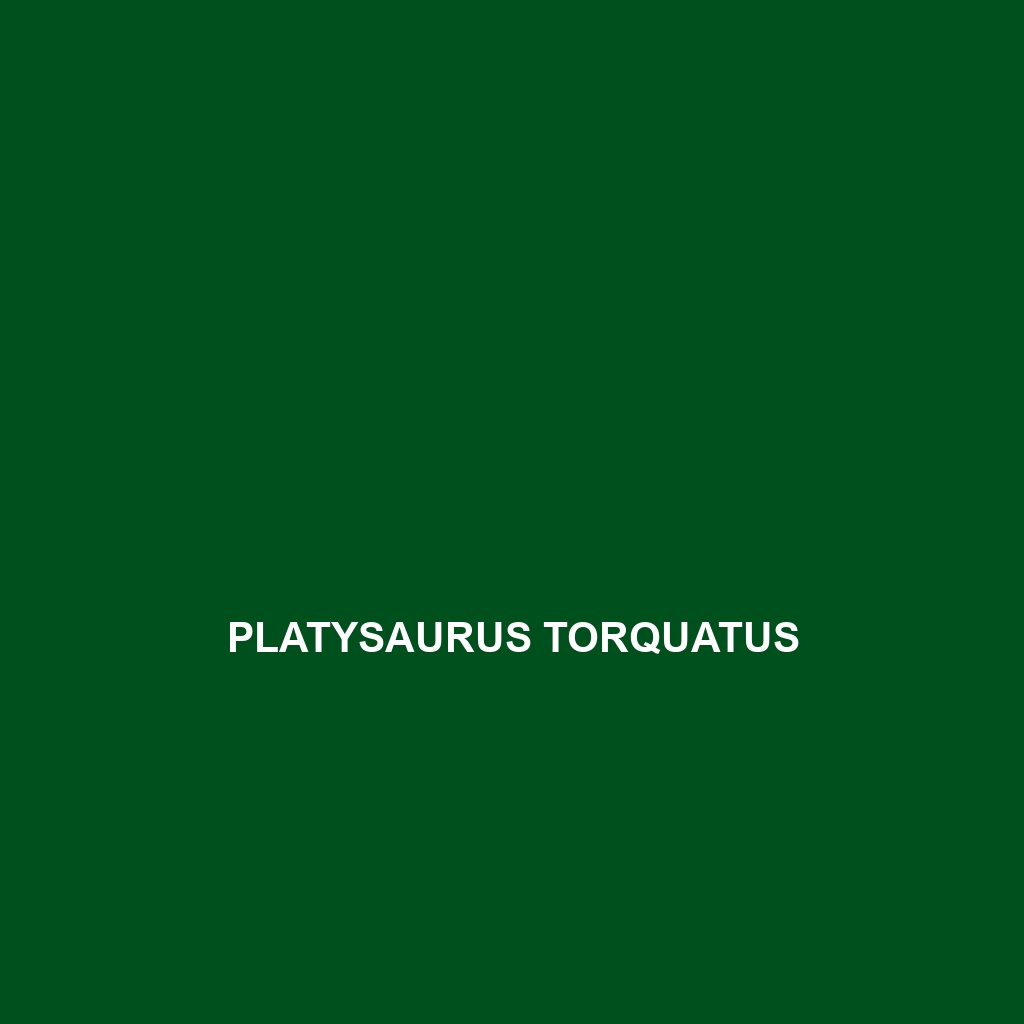Common Name
Platysaurus torquatus
Scientific Name
Platysaurus torquatus
Habitat
Platysaurus torquatus, commonly known as the Eastern Rock Lizard, is primarily found in southern Africa, specifically in regions of temperate forests, sandy savannas, and, less frequently, rocky outcrops. This species thrives in areas with abundant vegetation that provides shelter and basking spots, often close to water bodies. The climates in these regions range from mild to warm, characterized by seasonal rainfall which supports diverse insect populations. As a habitat specialist, Platysaurus torquatus relies heavily on its environment for thermoregulation and camouflage, making it an integral part of the ecosystem.
Physical Characteristics
Platysaurus torquatus stands out with its striking physical appearance. Typically, adults range in size from 15 to 25 cm in length, boasting a sleek body that is well-adapted for climbing and basking on rocks. Its skin exhibits a combination of earthy colors—ranging from olive green to brown—featuring intricate patterns that serve as effective camouflage against predators. One of the distinguishing features of this species is its vibrant coloration during mating season; males often display bright blue or orange hues to attract females. The lizard’s flattened body structure and large flattened head aid in its rock-climbing abilities, allowing it to navigate its habitat with ease.
Behavior
Platysaurus torquatus exhibits a range of interesting behaviors that are fascinating to observe. Primarily diurnal, these lizards are most active during the day, engaging in basking rituals to regulate their body temperature. They are territorial creatures; males often establish dominance through displays of color and aggressive posturing. Social interactions are marked by elaborate courtship displays during mating seasons, where males showcase vibrant colors to attract females. Interestingly, they also exhibit a unique form of communication through head-bobbing and tail movements. Although not known to migrate, their behaviors can change based on seasonal variations in food availability and temperature.
Diet
Platysaurus torquatus exhibits a primarily insectivorous diet but is classified as an omnivore due to occasional consumption of plant matter. Their diet mainly consists of various insects, including ants, beetles, and crickets, which they hunt with remarkable agility. They forage during the warmer parts of the day, demonstrating keen eyesight to locate prey among the leaves and rocks. This adaptability in their eating habits allows them to thrive in diverse environments, and they play a pivotal role in controlling insect populations within their habitats.
Reproduction
The reproductive cycle of Platysaurus torquatus typically spans the warmer months, peaking in the spring. Mating rituals are marked by competitive displays among males, with the successful mate showcasing vibrant colors to a receptive female. After mating, females usually lay a clutch of 4 to 12 eggs in protected areas like leaf litter or under rocks. The incubation period lasts about 8 to 10 weeks, depending on environmental conditions. Offspring are independent from birth, and parental care is minimal, emphasizing the lizards’ survival instincts from a young age.
Conservation Status
The IUCN lists Platysaurus torquatus as a species of Least Concern, indicating a stable population. However, habitat loss due to urban development and agricultural expansion poses potential threats to its long-term survival. Conservation efforts focus on habitat preservation and awareness programs, particularly in areas experiencing rapid human encroachment. Continuous monitoring is essential to mitigate any emerging threats to its populations.
Interesting Facts
One of the most intriguing aspects of Platysaurus torquatus is its remarkable adaptability; it can often change color to blend in with its surroundings as a defense mechanism against predators. Additionally, the species has been known to exhibit a fascinating behavior called ‘basking cluster’, where individuals gather closely together to maximize heat absorption during cooler mornings. This social behavior indicates a level of communal interaction that is relatively rare among lizard species.
Role in Ecosystem
Platysaurus torquatus plays a vital role in its ecosystem, acting as both a predator and prey. As an insectivore, it helps in regulating insect populations, promoting plant health and diversity. On the other hand, it serves as a food source for larger predators, including birds of prey and snakes. Its activity contributes to the overall balance of the ecosystem, supporting various food webs. Additionally, through their foraging behavior, these lizards aid in seed dispersal for some plant species, further enhancing biodiversity within their habitat.
This content is structured as a comprehensive description of the species Platysaurus torquatus, incorporating relevant SEO-friendly keywords while maintaining an informative tone. Each section provides critical insights into different aspects of the species, ensuring a well-rounded understanding for readers and search engines alike.
